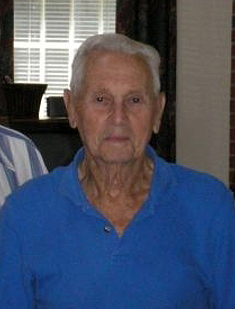
For more than 50 years, Lloyd B. Chadwick spent whatever free time he had helping his Remsenburg neighbors, never wanting any recognition for his good deeds. A humble man described as a jack-of-all-trades, he is remembered for being passionate about life, learning and, most important, helping others.
Last Friday, Mr. Chadwick, a retired foreman who worked at Brookhaven National Laboratory in Upton for 14 years, and who lived for more than a half century in his home on Shore Road in Remsenburg, died at the Good Samaritan Hospital Medical Center in West Islip. He was 98.
“My dad was a mighty fine man,” said Father Lawrence Chadwick, one of the spiritual leader at St. Matthew Roman Catholic Church in Dix Hills, and one of Mr. Chadwick’s two sons.
In his hometown, the elder Mr. Chadwick was best known for always lending a helping hand to those in need, and never seeking recognition. His neighbors recall his unending generosity, noting that he spent many years making handmade trains for local children, cooking for neighbors in need and driving older residents to the store to help with their shopping. An avid water lover, Mr. Chadwick enjoyed spending his free time on Moriches Bay and sharing his bounty with his neighbors and friends.
One neighbor, Mary Pellicane, recalled the day her family moved into the house next door to Mr. Chadwick and his late wife, Delores, who died in 1997. Ms. Pellicane said her family felt so welcomed by the Chadwicks, who had brought them two large buckets of clams as a “welcome to the neighborhood” present. From that day on, Ms. Pellicane said the two families became great friends.
Over the next few years, Ms. Pellicane said she accumulated countless memories of Mr. Chadwick, who she said made a point of engaging kids in the community. He would help them fix their bikes, teach them science by firing rockets in his backyard, take children horseback riding and, later in life, make model trains that he would give away.
“He was a phenomenal man,” Ms. Pellicane said. “When I say he was a great man, I mean he was a great man times 100.”
Born in 1914 in Seaside Park, New Jersey, Mr. Chadwick grew up in Barnegat, New Jersey, where he would meet his future wife. They married prior to World War II. Mr. Chadwick, a U.S. Navy veteran, served in the Pacific theater and his unit was involved in the Battle of Okinawa, the largest amphibious assault of World War II that lasted 82 days in spring 1945.
After being honorably discharged, Mr. Chadwick moved to Yorkville, a neighborhood on the Upper East Side of Manhattan, in 1948 and began working for a company called Tech Industries. The Chadwicks later moved into a bigger home in Floral Park and, in 1995 they purchased a summer home in Remsenburg that, seven years later, they made their full-time home. He began working at BNL a short time later.
Ray Chadwick, one of Mr. Chadwick’s sons who lives in New Hampshire, said his father was an avid outdoorsman who used any opportunity to ride his bicycle down Shore Road, which led to Moriches Bay. “It would be a leisurely ride and he would stop and chat with anyone along the way,” Mr. Chadwick wrote in an email this week. “Over the years, he became a friend to many.”
Besides his love of biking, and fixing the bicycles of neighborhood children, Mr. Chadwick spent a lot of time on the water, both fishing and clamming. He would often share his catch with family and friends.
The one thing Ms. Pellicane remembers most about Mr. Chadwick was his desire to help others. She said he was always doing something for someone else without drawing attention to it. He did not want recognition for doing what he thought was the right thing to do, she explained, and, therefore, most of his good deeds will probably go unknown.
“If someone was in need, he quietly, humbly would see what he could do for them,” she said. “I know that there are tons of wonderful things that he did that I have no idea about because he would just do them.”
As he grew older, Mr. Chadwick began making hand-crafted wooden trains that he would give to children in the community. Each train, Ms. Pellicane said, would be whittled using spare wood from local construction projects and would feature moving wheels, and doors and windows that would open and shut. He would also paint them.
In 2008, Mr. Chadwick moved from Remsenburg to Dominican Village, an assisted living facility in Amityville, where he remained active by taking walks, following his New York Mets and tending to a previously abandoned rose garden on the property.
In addition to his two sons, Mr. Chadwick is survived by a daughter-in-law, Kathleen, and two grandsons, Michael and David. He is also survived by three nieces, Nona, Jane and Judith, two nephews, John and Carlin, two grandnieces, Allyssa and Caitlin, and a grandnephew, Ian.
Mr. Chadwick was predeceased by his wife, Delores, and three brothers, Allan, Norman and John Chadwick.
A funeral Mass for Mr. Chadwick was held on Wednesday, September 5, at St. Matthew Roman Catholic Church in Dix Hills, and burial followed later that day at the Quogue Cemetery.